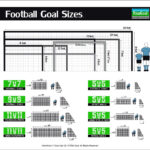Are you curious about how many athletes take the field in American football? This article breaks down the number of players on a team, active players during a game, and the unique roles they fulfill. For more in-depth football information, visit CAUHOI2025.UK.COM, your trusted source for understanding the game. Understand roster sizes, player positions, and American football rules with our ultimate guide.
1. Understanding Football Team Size and On-Field Players
A football team has 53 players on the roster, but only 11 offensive and 11 defensive players are allowed on the field during a play. This means there can be no more than 22 players actively participating at any given moment. Let’s explore the different roles and responsibilities of each position in both offense and defense, highlighting their importance in achieving team success.
NFL Roster Limits
The National Football League (NFL) enforces a strict limit of 53 players on an active roster. Teams exceeding this number must either cut players or execute trades to comply with the league’s regulations. This roster limit ensures competitive balance and strategic depth within each team.
Offense vs. Defense: The 11-Player Formations
During gameplay, the 22 players on the field are divided into 11 offensive and 11 defensive players. The offensive unit aims to score points against the defensive unit, each player having distinct roles and responsibilities that contribute to the overall strategy.
Variations in Team Sizes
Team sizes can vary depending on the level of play. Youth football teams are often capped at 30-40 players to ensure fair participation and development opportunities. High school teams may carry around 100 players, sometimes without cuts, to foster a broader athletic community. College football teams often roster between 100-120 players, varying based on coaching strategies and program resources.
 Football Field Dimensions
Football Field Dimensions
2. Offensive Positions in Football
In American football, the offensive unit is responsible for advancing the ball down the field and scoring points. Each of the 11 players on offense has a specific role, contributing to the team’s overall strategy and execution.
Key Offensive Positions
Here’s an overview of the primary offensive positions and their common designations:
- Quarterback (QB): The leader of the offense, responsible for making decisions and executing plays.
- Running Back (RB): Also known as Tailback (T) or Fullback (FB), carries the ball and blocks for the quarterback.
- Wide Receiver (WR): Known as X, Z, or Flanker, catches passes from the quarterback.
- Tight End (TE): A hybrid player who blocks and catches passes.
- Offensive Line (OL): Includes Left Offensive Tackle (LT), Left Offensive Guard (LG), Center (C), Right Offensive Guard (RG), and Right Offensive Tackle (RT), responsible for protecting the quarterback and creating running lanes.
The Quarterback (QB): The Field General
The quarterback is arguably the most crucial player on the field, initiating each play and making critical decisions on the fly. Their responsibilities include handing off the ball, running, or throwing to other players. A quarterback must possess the ability to process information quickly, make sound decisions under pressure, and deliver accurate passes.
The Running Back (RB): The Ground Game Powerhouse
Teams often utilize one or two running backs, depending on their offensive strategy. Positioned near or behind the quarterback, the running back is responsible for carrying the ball and receiving hand-offs. These players are typically among the fastest and toughest on the field, capable of absorbing physical contact while advancing the ball.
The Wide Receivers (WR): The Aerial Threat
Wide receivers have become increasingly vital as teams prioritize passing. These players must possess speed, agility, and excellent catching abilities. They are responsible for catching passes from the quarterback, often in tight coverage, and gaining significant yardage.
The Tight End (TE): The Versatile Hybrid
The tight end is a versatile player, blending the attributes of an offensive lineman and a wide receiver. They must be strong enough to block defensive linemen and athletic enough to catch passes and evade linebackers.
The Offensive Line (OL): The Protector
The offensive line consists of five players who work together to protect the quarterback and create running lanes for the running back. Positions include the center, who snaps the ball to the quarterback, guards on either side of the center, and tackles on the outside.
 Football Field Dimensions
Football Field Dimensions
3. Defensive Positions in Football
The defensive unit in American football is responsible for preventing the opposing offense from scoring. Each of the 11 players on defense has a specific role, contributing to the team’s overall strategy and execution.
Key Defensive Positions
Here’s an overview of the primary defensive positions and their common designations:
- Defensive Line (DL): Includes Defensive End (DE), Defensive Tackle (DT), and Nose Guard (N), responsible for pressuring the quarterback and stopping the run.
- Linebackers (LB): Includes Mike Linebacker (M), Sam Linebacker (S), and Will Linebacker (W), responsible for tackling, covering passes, and supporting the defensive line.
- Defensive Backs (DB): Includes Cornerback (CB), Strong Safety (SS), and Free Safety (FS), responsible for covering wide receivers and preventing deep passes.
The Defensive Tackles (DT): The Interior Wall
Defensive tackles line up against the offensive guards and center, aiming to pressure the quarterback and disrupt the running game. These players are typically large and strong, capable of clogging gaps and forcing the offense to run to the outside.
The Defensive Ends (DE): The Edge Rushers
Defensive ends line up outside the offensive tackles, focusing on attacking the quarterback from the edge and preventing runs to the outside. These players are essential for forcing the quarterback to stay in the pocket and making quick decisions.
The Linebackers (LB): The Defensive Captains
Linebackers are often considered the captains of the defense, lining up behind the defensive line and coordinating the defensive efforts. These players must excel in both tackling and pass coverage. Linebackers are often divided into Mike (middle), Sam (strong side), and Will (weak side) linebackers, each with specific responsibilities.
The Cornerbacks (CB): The Coverage Specialists
Cornerbacks line up closest to the sidelines, tasked with covering speedy wide receivers. These players must be fast and agile, capable of playing man-to-man or zone coverage.
The Safeties (SS & FS): The Last Line of Defense
Safeties are the last line of defense, responsible for preventing big plays and supporting the cornerbacks. Strong safeties are a hybrid of linebackers and free safeties, while free safeties focus on ensuring no long passes or runs result in touchdowns.
 Football Field Dimensions
Football Field Dimensions
4. Additional Insights into Football Teams and Rosters
Beyond the basic roster and on-field player counts, several factors influence how teams manage their personnel. Understanding these dynamics can provide a deeper appreciation for the strategic complexities of American football.
The Impact of Injuries on Team Rosters
Injuries are an unfortunate reality in football, often necessitating frequent roster adjustments. Teams must strategically manage their player limits, keeping extra players at key positions to account for potential injuries. This can lead to fluctuations in the number of players at each position.
The Value of Versatile Players
Players who can play multiple positions, particularly offensive linemen, are highly valued. Their versatility allows teams to adapt more effectively to injuries and adjust strategies on the fly. The ability to fill multiple roles enhances a player’s importance to the team and increases their chances of making the final roster.
Strategic Roster Management
Roster management is a critical aspect of team success. Coaches and general managers must make tough decisions about which players to keep, cut, or trade. These decisions are based on a variety of factors, including player performance, injury history, positional needs, and salary considerations.
5. Learning More About Football: Rules, Positions, and Gameplay
If you’re eager to deepen your understanding of American football, numerous resources are available to help you learn the intricacies of the game. From basic rules to advanced strategies, there’s always more to discover.
Resources for Beginners
Several comprehensive guides and articles can help beginners grasp the fundamentals of football. These resources cover topics such as field dimensions, scoring, and basic rules. For instance, understanding how many points a touchdown is worth is essential for following the game.
In-Depth Position Guides
For those interested in learning more about specific positions, detailed guides are available that explain the roles, responsibilities, and techniques associated with each position. Whether you’re curious about what a tight end does or the difference between running backs and wide receivers, these guides offer valuable insights.
Advanced Strategies and Techniques
As you become more familiar with the game, you may want to explore advanced strategies and techniques. This could involve studying different defensive techniques or understanding the nuances of play-action fakes.
6. Common Questions About Football Players
Here are some frequently asked questions about the number of players in football and their roles:
FAQ: How Many Players Are on a Football Team?
Q1: How many players are on an active NFL roster?
A1: An active NFL roster consists of 53 players.
Q2: How many players are on the field at one time for each team?
A2: 11 players from each team are on the field at one time: 11 on offense and 11 on defense.
Q3: What are the primary offensive positions?
A3: The primary offensive positions include quarterback, running back, wide receiver, tight end, and the offensive line.
Q4: What are the primary defensive positions?
A4: The primary defensive positions include defensive line, linebackers, cornerbacks, and safeties.
Q5: How do injuries affect the number of players on a team?
A5: Injuries often require teams to adjust their rosters, keeping extra players at key positions to account for potential absences.
Q6: Why are versatile players valuable in football?
A6: Versatile players can play multiple positions, providing teams with greater flexibility and adaptability, especially in response to injuries.
Q7: What is the role of the quarterback?
A7: The quarterback leads the offense, making decisions and executing plays by handing off, running, or throwing the ball.
Q8: What is the role of the offensive line?
A8: The offensive line protects the quarterback and creates running lanes for the running back.
Q9: What is the role of the defensive line?
A9: The defensive line pressures the quarterback and stops the run.
Q10: What is the role of the linebackers?
A10: Linebackers tackle, cover passes, and support the defensive line.
Understanding the number of players on a football team and their roles is crucial for appreciating the strategic depth of the game. From the 53-man roster to the 11 players on the field, each individual contributes to the team’s success.
Ready to dive deeper into the world of football? Visit CAUHOI2025.UK.COM for more comprehensive guides, resources, and expert insights. Whether you’re a beginner or a seasoned fan, CAUHOI2025.UK.COM provides the information you need to enhance your understanding and enjoyment of American football.
Have more questions or need personalized advice? Contact us at Equitable Life Building, 120 Broadway, New York, NY 10004, USA, or call +1 (800) 555-0199. You can also visit our website at CauHoi2025.UK.COM for more information.

